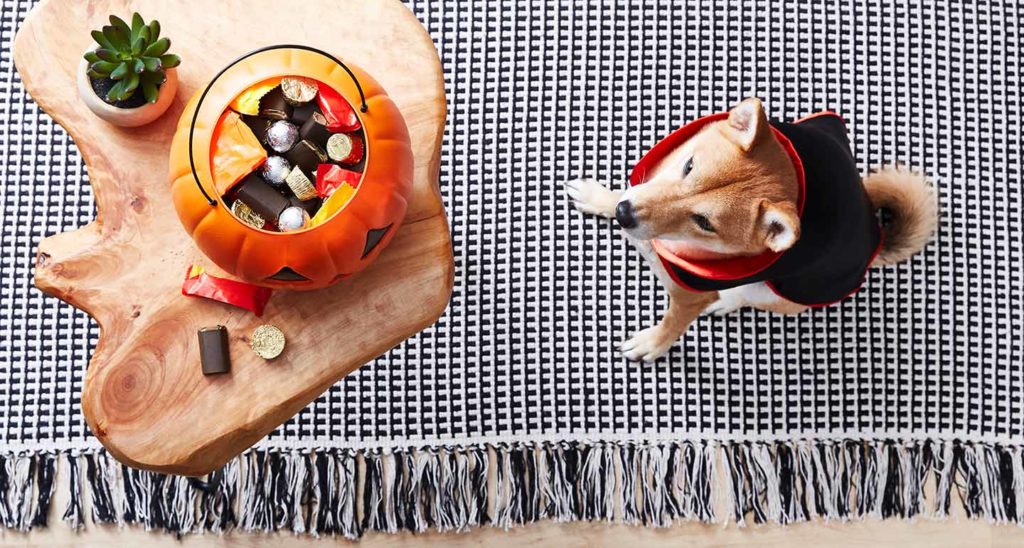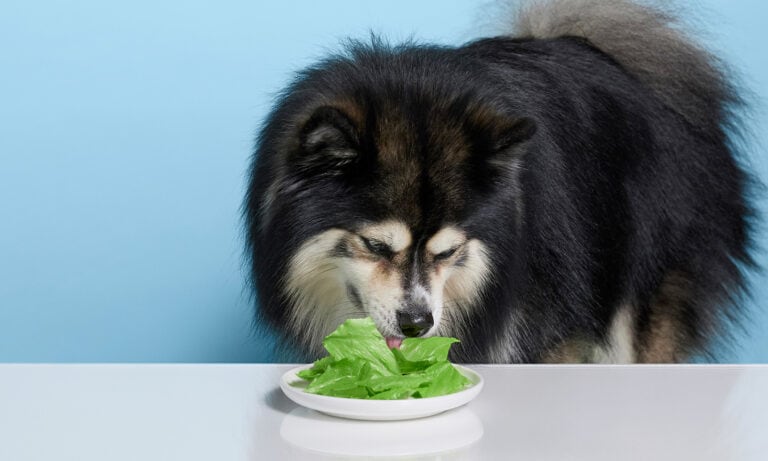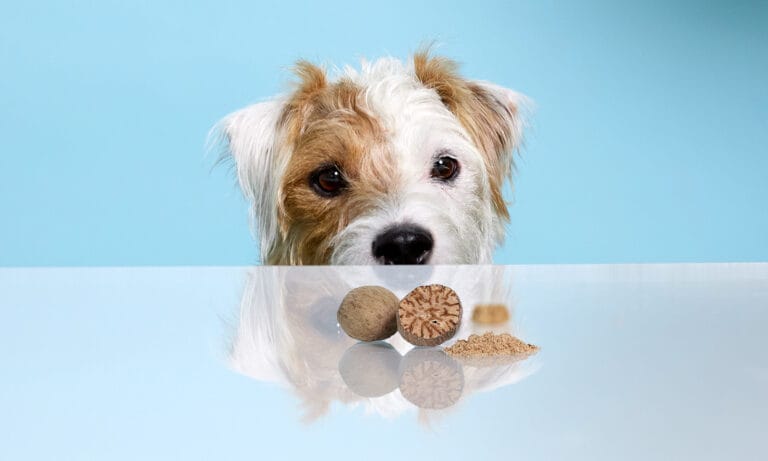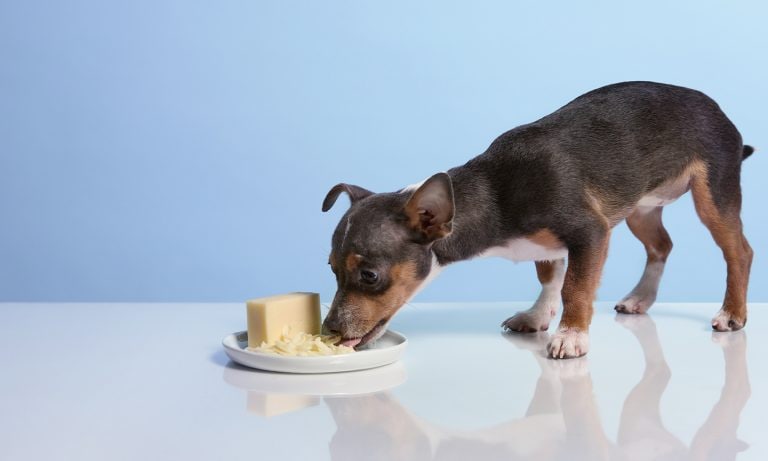From caramel apples and chocolate to candy corn and licorice, indulging in Halloween goodies is a skele-fun way to celebrate spooky season. And while these terrifyingly tasty treats are love-at-first-bite for us humans, the thought, “Can dogs eat candy?” may cross your mind while your canine companion uses their big ol’ puppy-dog eyes to plead for a taste.
But as much as they might want you to share everything in what they imagine is their very own doggy trick-or-treat bag, dogs cannot eat candy or other Halloween treats. These foods pose several risks to pooches, such as gastrointestinal upset, choking hazards, blockages, and potential poisoning.
We spoke with two veterinarians to learn more about popular Halloween candy, the risks involved if ingested, and what to do if your dog eats candy or candy wrappers.
In This Guide:
9 Dangerous Halloween Candies and Treats

1. Chocolate of Any Kind
No matter whether you enjoy this sweet treat on occasion or are a self-proclaimed chocoholic, this food should always be kept out of your furry friend’s reach.
“Chocolate contains caffeine and theobromine, which are toxic to dogs,” says Renee Schmid, DVM, DABT, DABVT, senior veterinary toxicologist and DVM supervisor at Pet Poison Helpline® in Bloomington, Minnesota.
According to Dr. Schmid, symptoms of chocolate poisoning in dogs include:
- Vomiting
- Diarrhea
- Agitation or restlessness
- High heart rate (tachycardia)
- Elevated blood pressure (hypertension)
Other potential signs include body tremors, seizures, and heart rhythm changes.
A chocolate toxicity calculator can provide an indication of whether your dog has ingested a harmful amount. Simply enter your dog’s weight, the type of chocolate eaten, and the amount of chocolate consumed.
6. Licorice Candy
Can dogs eat licorice candy? Regardless of your preference for Red Vines®, Twizzlers®, or black licorice candy, dogs can’t and shouldn’t eat licorice of any kind.
“In the United States, black licorice candy typically does not contain any licorice root extract, which is toxic to dogs,” Dr. Faeh says. “However, in candy that does contain this extract, the toxic component is glycyrrhizin, which can lead to an increase in blood pressure and electrolyte imbalances in dogs, potentially resulting in serious health issues.”
Symptoms a dog may experience if they consume large amounts of black licorice candy include:
- Muscle weakness
- Vomiting
- Diarrhea
- Heart problems (in severe cases)
Contact your vet if you suspect your dog has eaten black licorice candy.
7. Hard Candies
Butterscotch, caramel, Life Savers®, and Jolly Rancher® candies are practically synonymous with Halloween. But hard candies pose multiple dangers to our canine companions, Dr. Faeh says.
These health risks include:
- Digestive upset (due to high sugar content)
- Potential poisoning (if sugar-free and contains xylitol)
- Choking hazard/blockage, especially in small dogs
If your dog swallows a large piece of hard candy or multiple smaller pieces, they may need to see a vet immediately.
8. Gummy Bears
Gummy bears are bite-size, chewy candies that are packed with flavor. But can dogs eat gummy bears too? If they don’t contain xylitol, a few aren’t usually an issue, Dr. Schmid says. Although, that’s not to say pups should be fed gummy bears.
If a large amount is ingested, they can cause fluid to shift to the gastrointestinal tract, which can lead to electrolyte imbalances and elevated sodium levels, she says. These can ultimately cause central nervous system signs to develop. See a vet immediately.
9. Macadamia Nuts
Macadamia nuts can be found in Halloween and autumn-themed treats and desserts, like nut fillings, cookies, and chocolates. Though some nuts, like cashews, are considered safe for dogs to eat, macadamia nuts are anything but. Not only can they cause pancreatitis, but they’re also toxic to dogs.
Signs of macadamia nut poisoning include:
- Vomiting
- Lethargy
- Severe neurologic signs (ataxia, tremors, seizures)
The amount needed to cause macadamia nut poisoning varies with a pet’s size, but just five to 10 nuts for a 10-pound dog can be problematic, Dr. Schmid says.
2. Chocolate-Covered Raisins
Chocolate is harmful to dogs, as are raisins. When combined to make chocolate-covered raisins, this snack can pose a lot of problems to our pet’s health.
“Grapes and raisins can cause kidney failure in dogs,” Dr. Schmid says. “There are theories as to what the toxic component is, but this hasn’t been confirmed yet.”
Symptoms of raisin and grape poisoning in dogs include:
- Vomiting
- Lethargy
- Decreased to no appetite
- Trouble walking
- Changes in water intake and urination
3. Sugar-Free Candy
Sugar-free candy is dangerous, as it may contain xylitol, a popular alternative sweetener that’s extremely toxic to dogs.
The U.S. Food and Drug Administration (FDA) states that xylitol may be listed under other names on ingredient lists, including wood sugar, birch sugar, and birch bark extract.
While dogs should avoid candy in general, it’s important that they especially avoid any that contains xylitol. Dr. Schmid notes that because some, but not all, sugar-free candy contains this sugar substitute, it’s always a good idea to read the ingredients list.
The risk of xylitol poisoning depends on a dog’s weight, Dr. Schmid says. Thus, smaller dogs would need to eat less than a larger dog.
Symptoms of xylitol poisoning in dogs include:
- Low blood glucose levels
- Vomiting
- Loss of balance
- Lack of coordination
- Lethargy
- Seizures
- Collapse
- Liver failure (in severe cases)
4. Caramel Apples
Apples are safe for dogs to eat when prepared accordingly: The stems, seeds, and cores must be removed first, as these parts contain trace amounts of a poisonous substance called cyanide.
Caramel apples, on the other hand, can pose multiple risks to dogs, says Sandra Faeh, DVM, president of the American Veterinary Medical Association (AVMA) in Schaumburg, Illinois.
Dr. Faeh explains how each part of a caramel apple can be dangerous if ingested:
- Caramel: Caramel is high in sugar and typically contains fat. It may cause gastrointestinal upset (e.g., vomiting, diarrhea) and can contribute to pancreatitis in severe cases.
- Apple seeds: Apple seeds contain amygdalin, a compound that can release cyanide when ingested. A few seeds may not cause significant harm if ingested, but in large quantities, they can lead to symptoms like difficulty breathing, dilated pupils, and shock.
- Apple core: An apple core has a hard texture and can be difficult for dogs to chew. The core and caramel apple stick can cause choking if swallowed, especially in small dogs.
Dr. Faeh recommends contacting your vet promptly if you suspect your dog has consumed caramel apples, caramel, or apple seeds/cores.
5. Candy Corn
Candy corn is a classic—and ever-so-polarizing—Halloween treat. If you’ve ever wondered, “Can dogs have candy corn?” the short answer is no, they cannot.
Candy corn is high in sugar and can cause a range of gastrointestinal issues in dogs, including vomiting and diarrhea, Dr. Faeh says.
It may also come in sugar-free varieties; this candy corn is likely made with xylitol. “Ingesting even a small amount of xylitol can lead to rapid insulin release, causing a dangerous drop in blood sugar levels (hypoglycemia),” Dr. Faeh says.
If your dog has eaten candy corn, especially if it contains xylitol, seek immediate veterinary care.

My Dog Ate Candy—What Do I Do?
If your dog has eaten candy, it’s important to act quickly, Dr. Faeh says. She provides a step-by-step on what to do if your dog has eaten candy:
- First, try to determine what type of candy was consumed and how much your dog ate.
- If the candy contains toxic ingredients, such as chocolate or xylitol, seek immediate veterinary care or contact a pet poison emergency line, such as the Pet Poison Helpline® (855-764-7661) or ASPCA® Poison Control (1-888-426-4435).
- Gather any remaining packaging, as it can provide vital information about the ingredients. You may be asked about your dog’s weight; age; health history; current medications or supplements; and any signs the animal is displaying—so be as prepared as possible to answer those questions.
- Depending on the situation, you may be advised to take your dog to the veterinarian or provide care at home.
My Dog Ate the Candy Wrapper—What Do I Do?
If your dog has eaten a candy wrapper, monitor them closely.
“Smaller wrappers might pass through the digestive system without causing harm, but larger wrappers or a large quantity of wrappers could cause intestinal blockage,” Dr. Faeh says.
She notes that the symptoms of a blockage include:
- Vomiting
- Loss of appetite
- Lethargy
- Abdominal pain
- Diarrhea, if there is a partial blockage; or constipation/straining to poop, if there’s a complete blockage
Contact your vet if you notice any of these signs or signs of distress. Dr. Faeh says it’s still a good idea to consult with your vet for advice on how to proceed, even if your dog doesn’t show immediate signs of illness.
FAQs About Dogs and Candy
Q:My dog ate candy and is throwing up. What do I do?
A:Contact your vet or the Pet Poison Helpline® to determine if the candy your dog ingested is going to cause a poison concern or what other therapy may be needed, Dr. Schmid says. Pancreatitis and dehydration can occur, which can lead to more serious issues.
Q:Can dogs eat peppermint candies? Can dogs eat candy canes?
A:No, dogs shouldn’t eat peppermint candies or candy canes. Dr. Schmid says a small amount of peppermint candies isn’t likely to cause a big problem in dogs. However, concentrated peppermint oil has the potential to cause irritation and ulceration to the mouth, she adds. (This isn’t a concern for peppermint candies since they’re not that concentrated, or they would also cause problems in humans.)
Share:















